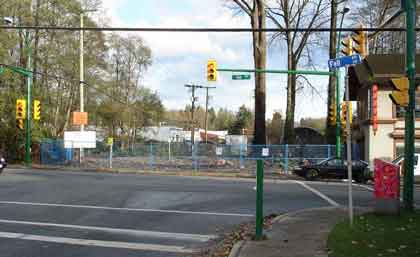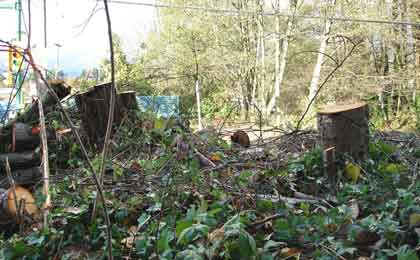|
|
NOT ANOTHER BRIDGE
|
|
|
In this area, south of Marine Drive, the stream corridor is very narrow with not much vegetation between the water and the street.
There's already a bridge around 250 feet north at Marine Drive, and a building too close to the creek at the south, on a lot which was previously public parkland.
|
|
|
|
It's also a location that the City of North Vancouver pledged to keep natural and green, after they sold the publicly owned parkland lot, and allowed it to be used for a commercial building.
|
|
|

|
|
|
City of North Vancouver Clear-Cuts the Salmon Stream
|
|
|
All the trees on the right have been removed since this photo was taken.
Tree trunks, branches and sawdust were left in the fish ladder, blocking salmon passage for days, at the height of spawning season, until the problem was
discovered and cleared by volunteers on December 4.
The clear-cut to the left of the trees is where the proposed bridge would be placed.
The building at right is on land that was public parkland before it was sold.
|
|
|
|
|
|
|
THE TROUBLE WITH BRIDGES
|
|
|
All bridges and their approaches cause ongoing problems for streams.
The impact is greater on small streams.
|
|
|
|
Debris, trash and contaminants get into the water. Exhaust fumes stay in the stream corridor.
|
|
|
The proposed development with 375 units would mean about 200 to 300 vehicles crossing this stream both ways each day. That's 400 to 600 crossings or more.
Since the cross street and traffic light are only about 60 feet from the creek, vehicles would have to idle on the bridge, over top of the creek, while waiting for traffic lights to change.
|
|
|
Vehicle traffic is noisy - from road surfaces and engines.
The sound carries far along the stream corridor - making larger areas not useable to songbirds and other wildlife. Great Blue Herons were often seen in this quieter part.
|
|
|
Wildlife habitat is permanently lost when the vegetation is removed and the tree canopy opened up to accommodate a bridge and its approach roads on each side. The bridge and roads can block wildlife or discourage them from crossing.
|
|
|

|
|
|
City of North Vancouver Clear-Cuts the Stream Habitat
|
|
|
The tree remains in the foreground are about 10 feet away from the proposed bridge.
The Fell Avenue curb is where the traffic light is on the left, the creek is on the far right about 15 feet past the edge of the photograph.
This habitat area is supposedly protected by the Streamside Protection Bylaws.
The City also promised to keep this site as natural green space to compensate for the sale of the publicly owned parkland lot to the south.
|
|
|
|
|
|
|
WHAT'S SO SPECIAL ABOUT THIS SPOT
|
|
|
Streams are not the same their entire length. Some sections are fast flowing, others are slower. Some sections have deep pools, cutbanks, or large boulders to shelter fish, others none at all.
The main stream of Mosquito Creek has few shelter areas. The best happen to be where the City wants to put another bridge.
|
|
|
Fish passage upstream is blocked from time to time, when debris gets into the fish ladder, making it even more important to keep this part of the creek healthy and protected.
The dense low growing plants on the edge of the stream, just above the ladder, provide essential cover and shelter for fish. (Removed in late November 2011.)
|
|
|
The creek is relatively narrow in this area, so that trees growing on each side touch at the top.
This tree canopy forms a protective tunnel. It helps block out noise, filter out traffic pollutants, and keep temperatures down. In warmer weather, it can be 15 degrees cooler inside the stream corridor. This keeps water temperatures lower as well, which means higher oxygen levels in the water - important for fish.
|
|
|
Clearing a hole in the canopy doesn't just make a gap. It causes an updraft - which pulls the cooler air out.
This is why it's important to keep continous tree cover all along both sides of a stream.
|
|
|
|
|
|
|
Lower Mosquito Creek, south of Marine Drive, is especially important to salmon because it has habitat and shelter not available elsewhere in the creek, and to other fish and wildlife because there are few streams left that stretch from the mountains to the inlet.
Satellite views of the North Shore show a largely continuous area of pavement and buildings.
Below the highway, stream corridors are very narrow. Severely reduced, their fragility is obvious.
|
|
|
Development has already caused many problems.
There is a real need to prevent further damage and to keep a continuous vegetated buffer zone all along the stream.
|
|
|
|
|
|
|
COUNCIL DECISION
|
|
|
|
On July 4, 2011, the City of North Vancouver's Mayor and Council voted (5 votes for, 1 vote against) to rezone the current City Yard land, located south of Marine Drive, to allow 375 residential units to be constructed, and to purchase and build new City Yard facilities on another site farther south.
|
|
|
An earlier Marine Drive Area Study opposed the construction of any housing south of Marine Drive.
Council did not give a reason why the City Yard site should be an exception.
|
|
|
|
Some councillors expressed concern over the proposed bridge over the creek, and asked city staff to try to find alternate access.
|
|
|
It would take about two years for the new City Yard to be ready, and for staff to move out of the old location. At that time, the current City Yard land would be developed.
The bridge would be constructed in the summer of 2012.
|
|
|
|
|
|
|
SPEAK FOR THE CREEK
|
|
|
|
Most members of the previous City Council did not see a problem with the bridge.
|
|
|
|
There is some possibility of having access from the site, north to Marine Drive, in the future when private properties are redeveloped.
|
|
|
There is already right-in/right-out access at the south end.
The reason more than one way is needed for access to and from the site, is because of the large number of housing units and vehicle parking spots (320) planned for the development.
|
|
|
If the housing complex (smaller or the same size) was built with space for only half the number of vehicles, then the bridge would not be so "essential".
|
|
|
Part of the City's rationale for putting housing on that site was its close proximity to public transit and walking trails, with less need for residents to own cars at all.
|
|
|
|
Comment or voice your opinion in a letter, email, or petition.
|
|
|
NOT ANOTHER BRIDGE
|
|
|
Refer to:
Proposed Bridge over Mosquito Creek
3rd Street and Fell Avenue
City of North Vancouver
|
|
|
Mail to:
Mayor and Council, City of North Vancouver
141 West 14th Street, North Vancouver, BC, V7M 1H9
|
|
|
|
Fax: 604-985-9417
|
|
|
Email to:
Mayor and Council at clerks@cnv.org
|
|
|
You can also email to each of the councillors individually.
Councillor Contact Info
|
|
|
|
|
|
|
|
Letter to the Editor, June 18, 2011, North Shore News, KR Milne
|
|
|
|
|
|

